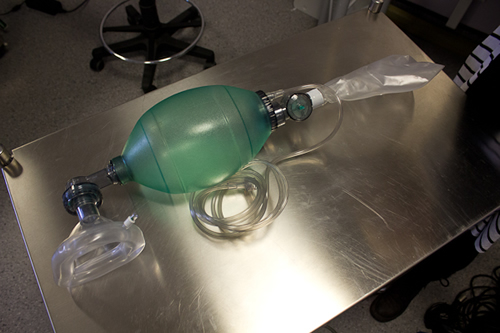Immediate assessment of the airway can be done using the
look, listen, feel approach.
BASIC AIRWAY MANOEUVRES
There are three basic airway manoeuvres that should be tried when managing an obstructed airway; head tilt with chin lift or jaw thrust. These are particularly useful when the cause of the obstruction is reduced consciousness and loss of the pharyngeal tone.
Head tilt with chin lift or jaw thrust
Video: Head tilt with chin lift or jaw thrust.
These manoeuvres are generally done together and can really be thought of as one. You place one hand on the patient’s forehead and the other with fingertips under the patient’s chin. You lift the chin upwards whilst simultaneously tilting the head back. This moves the head and neck into a more anatomically favourable position to open up the airway.
A head tilt is relatively contraindicated in a patient with a suspected cervical-spine injury, and alternative measures such as a jaw thrust should be used in these circumstances.
Jaw thrust
Placing fingers under the angle of the mandible and lifting upwards performs a jaw thrust. By lifting the mandible upwards the tongue, soft palate and epiglottis are pulled away from the posterior wall opening the airway.
AIRWAY ADJUNCTS
Oropharyngeal airway
Video: Sizing Oropharyngeal Airway.
The oropharyngeal airway or ‘Guedel’ airway is designed to be used in patients with a reduced conscious level to overcome the soft palate obstruction by preventing the backward displacement of the tongue. They are available in different sizes (2, 3 and 4 most common). The ‘correct’ size needs to be chosen as measured from the vertical distance from the patient’s incisors and angle of the jaw. Caution should be used in patients who are only lightly unconscious, as they may not have lost their laryngeal reflexes enough to tolerate an oropharyngeal airway, and gagging or laryngospasm may be triggered.
Nasopharyngeal airway
The nasopharyngeal airway is made from soft plastic, bevelled at one end and flanged at the other. It is inserted through the nose, perpendicular to the hard palate, with a slight twisting action, until the tip lies in the posterior pharynx. It is better tolerated than the oropharyngeal airway in patients who are not deeply unconscious. Because of a high incidence of bleeding/epistaxis after insertion they are generally best reserved for patients who do not tolerate an oropharyngeal airway. They are of use in patients whose mouths cannot be opened (such as in patients with seizures). They are relatively contraindicated in patients with fractures of the base of the skull.
Laryngeal mask airway
Video: Laryngeal Mask Airway.
The Laryngeal Mask Airway (LMA) consists of a wide-bore tube with an elliptical inflated cuff, which forms a seal around the laryngeal opening. It requires less skill and training to insert when compared to intubation but still requires some practice to recognise optimal positioning. An LMA can only be inserted if the patient is deeply unconscious or anaesthetised or it will trigger gagging and laryngospasm.
VENTILATING PATIENTS WITH A BAG AND MASK
Video: Two Person Technique.
If the patient is not breathing (apnoeic) then it will be necessary to
ventilate them with a bag and mask. Prior to ventilation ensure that the
airway is patent using the techniques described above. An obstructed airway
will become obvious if attempted ventilation fails to push air/oxygen through
the airway. A bag and mask is held tightly to the patients face to form a seal, then the bag is squeezed to give a breath. This is best done as a two-person technique with
one person holding the mask and the other squeezing the bag at a rate of 10-12
per minute. Observation for chest movement is required to ensure adequate
ventilation. A self-inflating bag can also be attached to an LMA or
endotracheal tube if already in situ.
Patients who are not quite apnoeic but are failing to breathe enough to
maintain oxygenation and carbon dioxide levels will also require ventilation.
Patients who are peri-arrest may appear to be ‘gasping’ or have
irregular breathing. Ventilation can still be done with a bag and mask in
this situation until help arrives for a more definitive plan such as
intubation.

Bag and mask. This is a self-inflating bag that can be connected to a mask in order to apply positive pressure to ventilate a patient. The self-inflating bag can also be connected to an LMA or endotracheal tube if in situ. This device can also be referred to as a bag-valve-mask or the proprietary name - an AMBU bag.
